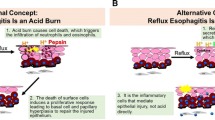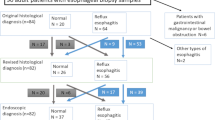Abstract
The molecular events responsible for the transdifferentiation of epithelial cells of the esophagus to a columnar cell type are not well understood. Cdx2 has been detected in Barrett’s esophagus, so we sought evidence of Cdx2 expression during the process of transdifferentiation of the esophageal squamous epithelium into a glandular phenotype. Thirty-two rats underwent an esophago-jejunostomy to produce esophagitis of 20, 25, 30, or 35 weeks of duration. The spectrum of esophageal lesions induced by chronic reflux was examined for expression of Cdx2 and Muc2 by immunohistochemistry. Five animals developed glandular metaplasia and adenosquamous carcinoma, two developed only glandular metaplasia, and two had adenosquamous carcinoma alone. Nuclear Cdx2 expression was detected in 57% (four of seven) and 43% (three of seven) of foci of glandular metaplasia and adenosquamous carcinomas, respectively. Cdx2 staining was detectable in some squamous and some mucus secreting cells. Perinuclear and perivacuolar staining of Muc2 was detected focally in 71% (five of seven) and 57% (four of seven) of areas with glandular metaplasia and adenosquamous carcinoma, respectively. We show that duodenal-content reflux into the esophagus switches on the expression of Cdx2 protein in esophageal keratinocytic cells, promoting a mucinous transdifferentiation process with secretion of intestinal mucin Muc2.

Similar content being viewed by others
References
Pohl H, Welch HG. The role of overdiagnosis and reclassification in the marked increase of esophageal adenocarcinoma incidence. J Natl Cancer Inst 2005;97:142–146.
Spechler SJ. Clinical practice. Barrett’s esophagus. N Engl J Med 2002;346:836–842.
Jankowski JA, Wright NA, Meltzer SJ, Triadafilopoulos G, Geboes K, Casson AG, Kerr D, Young LS. Molecular evolution of the metaplasia-dysplasia-adenocarcinoma sequence in the esophagus. Am J Pathol 1999;154:965–973.
Pera M. Experimental Barrett’s esophagus and the origin of intestinal metaplasia. Chest Surg Clin North Am 2002;12:25–37.
Miwa K, Sahara H, Segawa M, Kinami S, Sato T, Miyazaki I, Hattori T. Reflux of duodenal or gastroduodenal contents induces esophageal carcinoma in rats. Int J Cancer 1996;67:269–274.
Pera M, Brito MJ, Pera M, Poulsom R, Riera E, Grande L, Hanby A, Wright NA. Duodenal-content reflux esophagitis induces the development of glandular metaplasia and adenosquamous carcinoma in rats. Carcinogenesis 2000;21:1587–1591.
Pera M, Cardesa A, Bombi JA, Ernst H, Pera C, Mohr U. The influence of esophagojejunostomy on the induction of adenocarcinoma of the distal esophagus in Sprague–Dawley rats by subcutaneous injection of 2,6-Dimethylnitrosomorpholine. Cancer Res 1989;49:6803–6808.
Seery JP. Stem cells of the oesophageal epithelium. J Cell Sci 2002;115:1783–1789.
Su Y, Chen X, Klein M, Fang M, Wang S, Yang CS, Goyal RK. Phenotype of columnar-lined esophagus in rats with esophagogastroduodenal anastomosis: similarity to human Barrett’s esophagus. Lab Invest 2004;84:753–765.
Guo RJ, Suh ER, Lynch JP. The role of Cdx proteins in intestinal development and cancer. Cancer Biol Ther 2004;3:593–601.
Silberg DG, Swain GP, Suh ER, Traber PG. Cdx1 and cdx2 expression during intestinal development. Gastroenterology 2000;119:961–971.
Suh E, Traber PG. An intestine-specific homeobox gene regulates proliferation and differentiation. Mol Cell Biol 1996;16:619–625.
Almeida R, Silva E, Santos-Silva F, Silberg DG, Wang J, De Bolos C, David L. Expression of intestine-specific transcription factors, CDX1 and CDX2, in intestinal metaplasia and gastric carcinomas. J Pathol 2003;199:36–40.
Silberg DG, Furth EE, Taylor JK, Schuck T, Chiou T, Traber PG. CDX1 protein expression in normal, metaplastic, and neoplastic human alimentary tract epithelium. Gastroenterology 1997;113:478–486.
Yamamoto H, Bai YQ, Yuasa Y. Homeodomain protein CDX2 regulates goblet-specific MUC2 gene expression. Biochem Biophys Res Commun 2003;300:813–818.
Levrat M, Lambert R, Kirshbaum G. Esophagitis produced by reflux of duodenal contents in rats. Am J Dig Dis 1962;7:564–573.
Karlsson NG, Johansson ME, Asker N, Karlsson H, Gendler SJ, Carlstedt I, Hansson GC. Molecular characterization of the large heavily glycosylated domain glycopeptide from the rat small intestinal Muc2 mucin. Glycoconj J 1996;13:823–831.
Hanby AM, Pera M, Filipe I, Duranceau A, Wright NA, Pera M, Grande L, Poulsom R. Duodenal content reflux esophagitis in the rat. An animal model for the ulcer-associated cell lineage (UACL)? Am J Pathol 1997;151:1819–1824.
Shields HM, Zwas F, Antonioli DA, Doos WG, Kim S, Spechler SJ. Detection by scanning electron microscopy of a distinctive esophageal surface at the junction of squamous and Barrett’s epithelium. Dig Dis Sci 1993;38:97–108.
Glickman JN, Chen YY, Wang HH, Antonioli DA, Odze RD. Phenotypic characteristics of a distinctive multilayered epithelium suggests that it is a precursor in the development of Barrett’s esophagus. Am J Surg Pathol 2001;25:569–578.
Beck F, Chawengsaksophak K, Luckett J, Giblett S, Tucci J, Brown J, Poulsom R, Jeffery R, Wright NA. A study of regional gut endoderm potency by analysis of Cdx2 null mutant chimaeric mice. Dev Biol 2003;255:399–406.
Silberg DG, Sullivan J, Kang E, Swain GP, Moffett J, Sund NJ, Sackett SD, Kaestner KH. Cdx2 ectopic expression induces gastric intestinal metaplasia in transgenic mice. Gastroenterology 2002;122:689–696.
Eda A, Osawa H, Satoh K, Yanaka I, Kihira K, Ishino Y, Mutoh H, Sugano K. Aberrant expression of CDX2 in Barrett’s epithelium and inflammatory esophageal mucosa. J Gastroenterol 2003;38:14–22.
Moons LM, Bax DA, Kuipers EJ, Van Dekken H, Haringsma J, Van Vliet AH, Siersema PD, Kusters JG. The homeodomain protein CDX2 is an early marker of Barrett’s oesophagus. J Clin Pathol 2004;57:1063–1068.
Phillips RW, Frierson HF Jr., Moskaluk CA. Cdx2 as a marker of epithelial intestinal differentiation in the esophagus. Am J Surg Pathol 2003;27:1442–1447.
Spechler SJ. Barrett’s esophagus: a molecular perspective. Curr Gastroenterol Rep 2005;7:177–181.
Marchetti M, Caliot E, Pringault E. Chronic acid exposure leads to activation of the cdx2 intestinal homeobox gene in a long-term culture of mouse esophageal keratinocytes. J Cell Sci 2003;116:1429–1436.
Kazumori H, Ishihara S, Rumi MA, Kadowaki Y, Kinoshita Y. Bile acids directly augment caudal related homeobox gene Cdx2 expression in oesophageal keratinocytes in Barrett’s epithelium. Gut 2006;55:16–25.
Tatsuta T, Mukaisho K, Sugihara H, Miwa K, Tani T, Hattori T. Expression of Cdx2 in early GRCL of Barrett’s esophagus induced in rats by duodenal reflux. Dig Dis Sci 2005;50:425–431.
Acknowledgements
We wish to thank Dr. G.C. Hansson, Department of Medical Biochemistry, Goteborg University, Sweden, for kindly providing us with the anti-rat Muc2 polyclonal antibody and Dr. Antonio Martinez and Marta Garrido for technical assistance.
Author information
Authors and Affiliations
Corresponding author
Additional information
This work was supported by grant from the Fundació “La Caixa” (LC 02/126-00) and by grant Red de Centros 02/03, Instituto de Salud Carlos III, Spain
Rights and permissions
About this article
Cite this article
Pera, M., Pera, M., de Bolós, C. et al. Duodenal-content Reflux Into the Esophagus Leads to Expression of Cdx2 and Muc2 in Areas of Squamous Epithelium in Rats. J Gastrointest Surg 11, 869–874 (2007). https://doi.org/10.1007/s11605-007-0162-7
Published:
Issue Date:
DOI: https://doi.org/10.1007/s11605-007-0162-7




